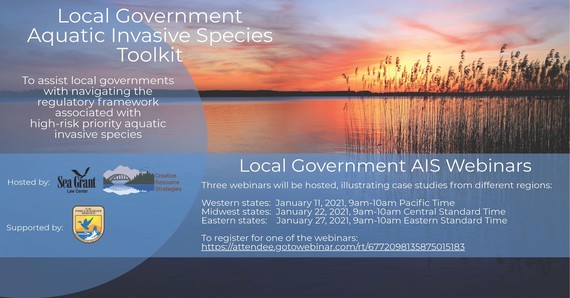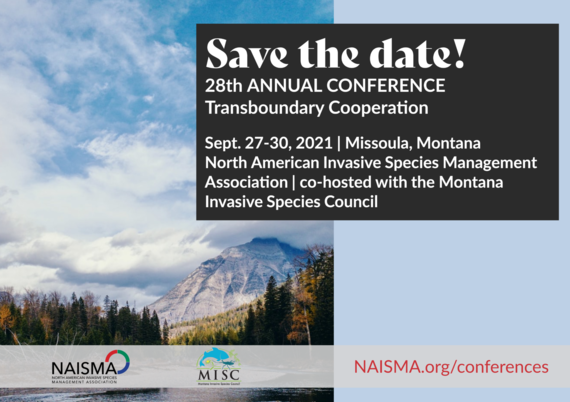|
The Invasive Species Bulletin provides you with all the latest news on invasive species in Montana and the region. Please let us know if you have any suggestions, contributions, questions, corrections, or comments. Email: scriswell@mt.gov

The Role of Local Municipalities and Entities in Addressing Aquatic
Invasive Species
Creative Resource Strategies, LLC and National Sea Grant Law Center, with funding from the US Fish and Wildlife Service, developed a project focused on helping municipalities access the tools necessary to play a role in aquatic invasive species prevention efforts. Although a substantial amount of attention has been placed on federal and state invasive species policy needs, the potential exists for municipalities to play a significant role in invasive species prevention efforts by addressing key gaps not addressed by state and federal regulations.
Specifically, the project developed an online handbook/toolkit (www.localgovAIS.com) for local entities (municipalities and counties) that guides them through the process of identifying high-risk priority AIS and key next steps they could potentially take to advance interdiction efforts. We understand that local water bodies are an important source of water for local communities, and generate significant revenue for local communities through recreational and other opportunities. The result is that local municipalities nationwide have an online toolkit to guide them through potential appropriate actions and strategies that align with state and federal laws, but that help to protect the health and integrity of their local water bodies, and advance AIS efforts overall.
A series of 1-hour webinars in January to share the Local Government Aquatic Invasive Species online toolkit with local governments (and others that are interested) and walk through the regional case studies. Each of the three webinars we are hosting will be similar – the one difference is that we’ll be emphasizing a water body in different regions of the country when we deliver the webinars. But anyone is welcome to register for any of the webinars.
- Western States: January 11, 2021, 9 am PT
- Midwest States: January 12, 2021, 9 am CT
- Eastern States: January 27, 2021, 9 am ET
To register - https://register.gotowebinar.com/rt/6772098135875015183 [lnks.gd]
Capturing 40 years of climate change for an endangered Montana prairie
They give you shade. They provide oxygen. Let’s make sure trees everywhere can do the same for future generations. If you’re a camper heading out for a trip — or just getting firewood for your wood stove — do nature a favor. Don’t move firewood long distances — it can potentially transport invasive species. Instead, buy it where you’ll burn it, buy certified heat-treated firewood — or gather on site where permitted. The forests, and your great-great-grandkids, will thank you. Read more.
AIS Grants Available!
The Montana Invasive Species Council is now accepting grant applications to fund aquatic invasive species projects. Up to $50,000 is available per project to Montana communities or local, state, tribal, or other entities within the state and to Montana-based non-governmental entities. AIS Grant Program Guidelines.
Deadline February 4, 2021.
Montana, Washington join forces to stop feral pigs
HELENA, MONT., OLYMPIA, WASH. – The Montana and Washington invasive species councils have joined forces to stop wild pigs from crossing borders.
The two councils issued a report with recommendations and best management practices aimed at helping federal, state, provincial and local landowners manage wild pigs in the western United States and Canada...Read more.
Recommendations Report
Report details how to combat invasion of feral pigs, Daily Inter Lake, 1/6/2021
The Updated Recommendations for the Quagga Zebra Action Plan for Western U.S. Waters (QZAP 2.0)
The purpose of the QZAP 2.0 is to provide a systematic and unified approach to prevent the spread of zebra and quagga mussels into and within the western US in the future. These recommendations are intended to inform decision‐making to provide increased capacity and clear direction that empowers the further implementation of a collaborative multi‐jurisdictional regional strategy to prevent the spread of quagga and zebra mussels in the West.
The original QZAP and the 2019 Status Report can be found here.
Western Governors' Association Launches Invasive Species Data Sharing Campaign
How best to battle the advance of invasive species in the West? It's a multi-pronged attack, but high-quality information is a key element to a winning strategy. That's why WGA launched its Invasive Species Data Mobilization Campaign, to enable wider sharing of useful invasive species occurrence data, with a webinar held last December 16. The webinar, hosted by WGA and the North American Invasive Species Management Association, featured representatives from the four existing invasive species data management platforms -- EDDMapS, iMapInvasives, BISON, and USGS NAS -- discussing the importance of data standardization and sharing. Watch the webinar here.
Read the 2018 WGA Invasive Species Data Management Workshop's findings and recommendations here.
More news:
MSU Extension Service Weed Post | Jan 2021 - NEW! Plant Identification Videos created by Noelle Orloff, Extension Associate Specialist and Plant Identification Diagnostician at the Schutter Diagnostic Lab. White byrony and Hoary alyssum
How climate change is disrupting ecosystems, Science Daily 12/17
Events
Jan. 20-21, Regional Invasive Species and Climate Change (RISCC) Management Symposium, virtual
Feb 1-10, National Association of Conservation Districts Annual Meeting, virtual
February 10, Upper Columbia Conservation Commission Meeting, virtual
February 17, Northern Pike Regional Forum, virtual, details to come
March 4, Montana Invasive Species Council Meeting, virtual
April 6-8, Northwest Climate Conference, virtual
May 18-20, North American Invasive Species Forum, Montreal, Quebec
September, Western Regional Panel, details to come
Sept- 27-30, North American Invasive Species Management Association Conference co-hosted with MISC, Missoula

Publications
The Elephant in the Lab (and Field): Contamination in Aquatic Environmental DNA Studies [frontiersin.org]
The rapid evolution of environmental (e)DNA methods has resulted in knowledge gaps in smaller, yet critical details like proper use of negative controls to detect contamination. Detecting contamination is vital for confident use of eDNA results in decision-making. We conducted two literature reviews to summarize (a) the types of quality assurance measures taken to detect contamination of eDNA samples from aquatic environments, (b) the occurrence, frequency and attribution (i.e., putative sources) of unexpected amplification in these quality assurance samples, and (c) how results were interpreted when contamination occurred. In the first literature review, we reviewed 156 papers and found that 91% of targeted and 73% of metabarcoding eDNA studies reported inclusion of negative controls within their workflows. Read more.
When Extinction is Warranted: Invasive Species, Suppression-Drives, and the Worst-Case Scenario
Thresher, A. C. (2020). When Extinction is Warranted: Invasive Species, Suppression-Drives, and the Worst-Case Scenario. Ethics, Policy & Environment.
Abstract: Most current techniques to deal with invasive species are ineffective or have highly damaging side effects. To this end suppression-drives based on clustered regularly inter-spaced short palindromic repeats (CRISPR/Cas9) have been touted as a potential silver bullet for the problem, allowing for a highly-focused, humane, and cost effective means of removing a target species from an environment. Suppression-drives come with serious risks that seem to warrant appeals to the precautionary principle, however, wherein our lack of understanding of the risks and relevant probabilities is taken as reason to avoid deploying the drive. The focus of this paper is on one such risk – the danger of a suppression-drive escaping containment and wiping out the target species globally. Here, I argue that in most cases this risk is significant enough to warrant holding off on the technology. In some cases, however, we can bypass the precautionary principle by using a dominance approach that hinges on what I term the ‘Worst-Case Clause’. This clause, in turn, provides us with a litmus test that can be fruitfully used to determine what species are viable targets for suppression-drives in the wild. Using this metric in concert with other considerations, I suggest that only three species are currently possible viable targets – the European rabbit, ship rat, and Caribbean Tree Frog. Read more.
Webinars
January 22, 2021, 9:00-10:00 a.m. EDT - Hemlock Rescue! Collaborating to stop the spread of hemlock woolly adelgid. Hemlock woolly adelgid has killed hundreds of thousands of hemlock trees in eastern states, including significant areas in the Appalachian and Great Smoky mountains. When infestations began spreading in West Michigan, a team of technicians went to work to “hold the line” through rigorous survey and treatment of infested trees in an effort to save Michigan’s 170 million eastern hemlocks from the same fate. Click here for information and to register.
January 2021 Wisconsin Tribal Conservation Advisory Council, Emerald Ash Borer Web Series Every Thursday afternoon for at least six consecutive weeks, on a variety of regional themes. Click here for more information and to register.
Webinar Recordings
Western Governors Association Invasive Species Data Mobilization Campaign
Montana AIS Summit – Nov. 18 (enter passcode 9#CG+Ul6 when prompted)
USACE: Invasive Watermilfoil Management - Nov. 12
Columbia Basin CWMA - Nov. 12
USACE: Flowering Rush - Nov. 4
Funding Opportunities
Montana DNRC Forestry Division - Montana Forest Action Plan Implementation Program. Request For Proposals. Deadline: January 29, 2021
Aquatic Invasive Species Grants. Deadline: February 4, 2021 by 5 p.m.
The Aquatic Nuisance Species Task Force requests proposals to build upon previous assessments and evaluate aspects of the Stop Aquatic Hitchhikers! campaign, Clean Drain Dry Initiative™, and PlayCleanGo campaign to determine what messages and delivery strategies are most effective to achieve desired behavioral changes.
Grants.gov Opportunity Number: F21AS00229 , March 10, 2021.
|